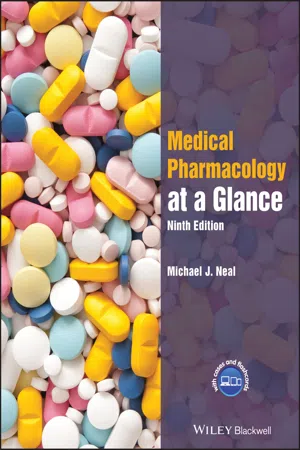
- English
- ePUB (mobile friendly)
- Available on iOS & Android
Medical Pharmacology at a Glance
About this book
The internationally best-selling Medical Pharmacology at a Glance is the ideal companion for all medical and healthcare students, providing a visual overview of pharmacology, and describing the basic principles of drug action, interaction, absorption, and excretion. Clear and accessible chapters organised around common diseases and conditions facilitate efficient clinical learning, and include references to drug classes and side effects, disease pathophysiology, prescribing guidelines, and more.
Now in its ninth edition, this leading guide has been thoroughly updated to reflect current guidelines and drug information. This edition features new and revised illustrations, additional pedagogical tools, and enhanced online content. Widely recognised as both the best introduction to medical pharmacology and the perfect revision tool for USMLE and pharmacology exams, this invaluable guide:
- Covers a wide range of drugs used to treat conditions such as hypertension, anaemias, cancer, and affective disorders
- Explains drug mechanisms and the principles of drug action
- Discusses practical topics including drug misuse, drug indications, and side effects
- Includes a companion website featuring online cases, flashcards, and a list of core drugs
Frequently asked questions
- Essential is ideal for learners and professionals who enjoy exploring a wide range of subjects. Access the Essential Library with 800,000+ trusted titles and best-sellers across business, personal growth, and the humanities. Includes unlimited reading time and Standard Read Aloud voice.
- Complete: Perfect for advanced learners and researchers needing full, unrestricted access. Unlock 1.4M+ books across hundreds of subjects, including academic and specialized titles. The Complete Plan also includes advanced features like Premium Read Aloud and Research Assistant.
Please note we cannot support devices running on iOS 13 and Android 7 or earlier. Learn more about using the app.
Information
1
Introduction: principles of drug action

- pharmacodynamics – the effects of the drug on the body; and
- pharmacokinetics – the way the body affects the drug with time (i.e. absorption, distribution, metabolism and excretion).






Receptors
- Agonist (ligand)‐gated ion channels are made up of protein subunits that form a central pore (e.g. nicotinic receptor, Chapter 6; γ‐aminobutyric acid (GABA) receptor, Chapter 24).
- G‐protein‐coupled receptors (see below) form a family of receptors with seven membrane‐spanning helices. They are linked (usually) to physiological responses by second messengers.
- Nuclear receptors for steroid hormones (Chapter 34) and thyroid hormones (Chapter 35) are present in the cell nucleus and regulate transcription and thus protein synthesis.
- Kinase‐linked receptors are surface receptors that possess (usually) intrinsic tyrosine kinase activity. They include receptors for insulin, cytokines and growth factors (Chapter 36).
Transport systems
Table of contents
- Cover
- Table of Contents
- Preface
- Acknowledgements
- Further reading
- List of abbreviations
- Core drugs
- About the companion website
- 1 Introduction
- 2 Drug–receptor interactions
- 3 Drug absorption, distribution and excretion
- 4 Drug metabolism
- 5 Local anaesthetics
- 6 Drugs acting at the neuromuscular junction
- 7 Autonomic nervous system
- 8 Autonomic drugs acting at cholinergic synapses
- 9 Drugs acting on the sympathetic system
- 10 Ocular pharmacology
- 11 Asthma, hay fever and anaphylaxis
- 12 Drugs acting on the gastrointestinal tract I
- 13 Drugs acting on the gastrointestinal tract II
- 14 Drugs acting on the kidney
- 15 Drugs used in hypertension
- 16 Drugs used in angina
- 17 Antiarrhythmic drugs
- 18 Drugs used in heart failure
- 19 Drugs used to affect blood coagulation
- 20 Lipid‐lowering drugs
- 21 Agents used in anaemias
- 22 Central transmitter substances
- 23 General anaesthetics
- 24 Anxiolytics and hypnotics
- 25 Antiepileptic drugs
- 26 Drugs used in Parkinson’s disease
- 27 Antipsychotic drugs (neuroleptics)
- 28 Drugs used in affective disorders: antidepressants
- 29 Opioid analgesics
- 30 Drugs used in nausea and vertigo (antiemetics)
- 31 Drug misuse and dependence
- 32 Non‐steroidal anti‐inflammatory drugs (NSAIDs)
- 33 Corticosteroids
- 34 Sex hormones and drugs
- 35 Thyroid and antithyroid drugs
- 36 Antidiabetic agents
- 37 Antibacterial drugs that inhibit nucleic acid synthesis
- 38 Antibacterial drugs that inhibit cell wall synthesis
- 39 Antibacterial drugs that inhibit protein synthesis
- 40 Antifungal drugs
- 41 Antiviral drugs
- 42 Drugs acting on parasites I
- 43 Drugs acting on parasites II
- 44 Drugs used in cancer
- 45 Immunosuppressants and antirheumatoid drugs
- 46 Poisoning
- 47 Adverse drug reactions
- Case studies and questions
- Answers
- Index
- End User License Agreement